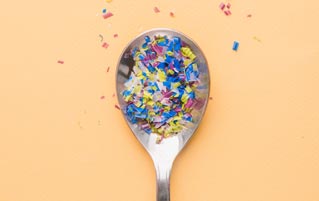Uh, You're Eating More Plastic Than You Realize

When they first burst onto the scene, people thought that plastics were the way of the future. And they weren't wrong. There's a plastic version of almost everything, and there's no denying that it's highly useful and convenient. Trouble is, plastic is now everywhere. Including inside our bodies.
A recent study determined that humans consume, on average, a credit card's worth of plastic ... every single week. In six months, we eat the equivalent of a cereal bowl full of the stuff. In a lifetime, we ingest an estimated 44 pounds of plastic. That's more than six Yorkshire Terriers. How on Earth are we able to swallow that much and not know it? Well, one reason our grandparents thought plastic was hot shit is the fact that it doesn't biodegrade; it just breaks down into smaller and smaller pieces. These "microplastic particles" (anything less than 5 mm in diameter) then make their way into waterways and soil, entering the food chain, and eventually us.
The sad truth is that every piece of plastic ever made still exists. Our bodies today contain bits of our parents' and grandparents' toothbrush bristles, plastic bags, and used condoms. Don't say Nana never gave you anything.
Related: 26 Foods You Wouldn't Eat If You Knew How They're Made

But their waste is a drop in the bucket compared to what we generate today. In 2015, humans produced 420 million tons of plastic, compared to a mere 2 million pounds back in 1950. Worse still, in that span of 65 years, we managed to use and trash 6 billion tons, which is now in landfills or nature, where it's degrading into nanoparticles. In 2019, scientists determined that even in remote portions of the Pyrenees, microplastic falls from the sky at a rate of 365 particles per square meter, every single day. Even in the furthest corners of the world, it's literally raining plastic.
But it's not just those of us standing outside with open mouths catching plastic snowflakes on our tongues who end up ingesting the stuff. Many of these particles originate a lot closer to home. Fleece jackets and other clothing made from synthetic fabrics (i.e. a type of plastic) shed microfibers every time they're washed. Inside your washing machine, those tiny pieces of plastic lint make their way down the drain and enter the environment, eventually making their way into waterways and then the fish we eat.
Related: Bizarre Stuff You Unknowingly Eat

We also end up breathing or eating tiny particles of our car's tires, the reflective paint off roads, glitter, microbeads in sunscreen ... you get the idea. So the big question is: What will this disco ball of plastic our bodies are collecting end up doing to us in the long run? The short answer is that we aren't completely sure. Yet.
However, as the problem of microplastic pollution grows and more research is conducted, "Evidence regarding microplastic toxicity and epidemiology is emerging." What we do know for sure is that plastics contain (and leach) chemicals like BPA or BPS, and other things we're not intended to eat, many of which we know are harmful. We also know that they absorb chemicals known to be toxic, like POPs (persistent organic pollutants) such as DDT or Dioxin.
With so many studies still in their infancy, plus the fact that microplastic pollution is relatively new on our radar, only time will tell just how awful plastics are or aren't for our bodies. Until then, it might be a good idea to take steps toward reducing both microplastic waste and consumption, as opposed to relying on a "Wait and see if we get superpowers or super-cancer" approach.
For more, check out 6 Ways The Food Industry Tricks You Into Eating Garbage - The Spit Take:
Follow us on Facebook. Nom nom nom.